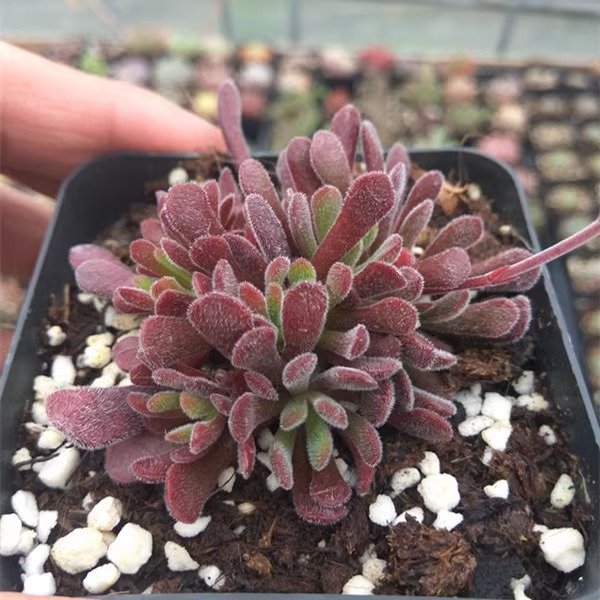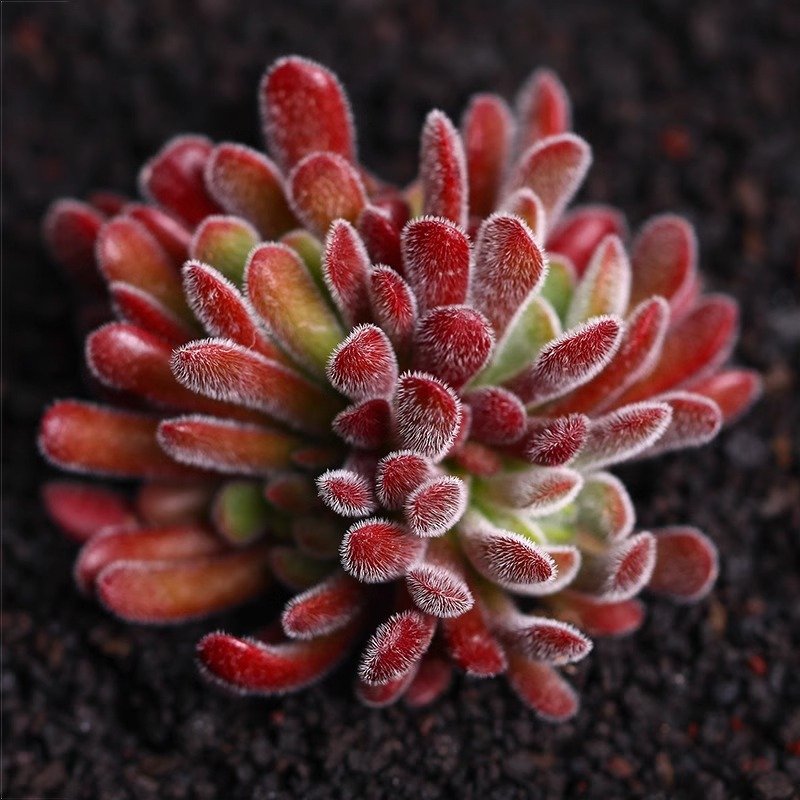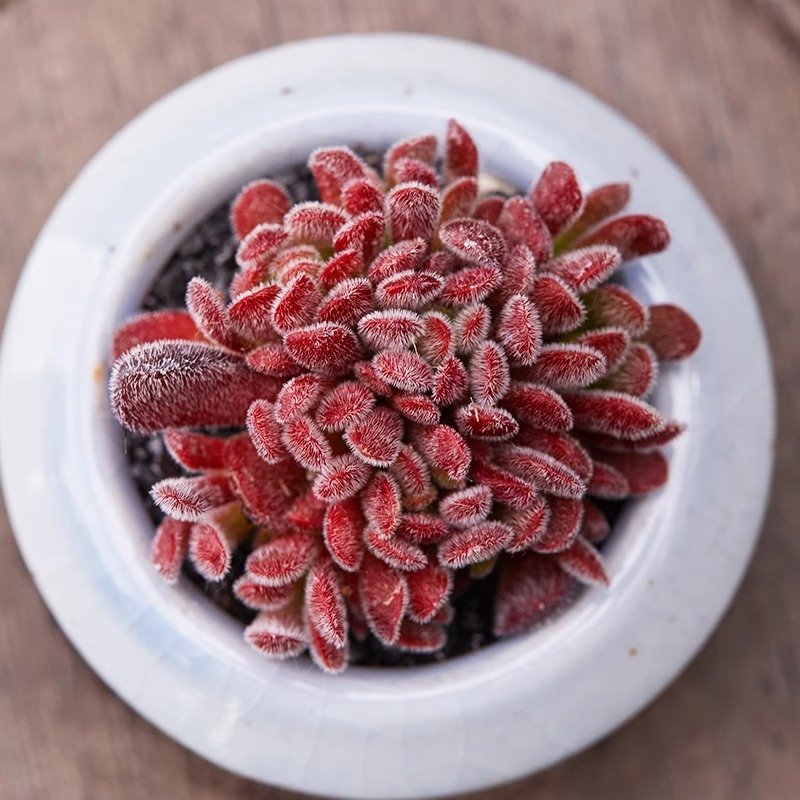
Crassula pubescens ssp. pubescens stands out with its fuzzy, rabbit-ear-shaped leaves. The leaves feel soft and often change color with the seasons. In winter, the plant shows a red bean shade, while in summer or low light, the leaves turn grass-like green. The leaves come off easily, which helps gardeners grow new plants from cuttings. This small succulent grows in tight clusters, making it easy to spot.
Key Takeaways
- Crassula pubescens ssp. pubescens has soft, fuzzy leaves shaped like rabbit ears that change color from green to red or purple depending on the season and sunlight.
- This small succulent grows in tight, upright clusters up to 12 inches tall and spreads about 9 to 12 inches wide, making it perfect for pots and small gardens.
- The stems are fragile, fuzzy, and stand upright without rooting when touching soil, helping the plant keep a neat, bushy shape.
- Its small, star-shaped flowers usually bloom in late winter or spring, appearing in clusters at the tips of stems with pale or white petals.
- To identify this plant, look for pairs of velvety leaves that hug the stem and upright stems that do not spread or root, distinguishing it from similar species.
Size and Growth
Height and Spread
Crassula pubescens ssp. pubescens stays small all its life. Most plants grow between 4 and 8 inches tall. The plant can spread from 9 to 12 inches wide. This makes it good for small pots or groups of plants. It almost never gets taller than 12 inches, even if it grows really well. Most grown plants stay close to the ground. They make a thick mat with their leaves and stems.
| Attribute | Measurement |
|---|---|
| Average Height | Up to 12 inches (30 cm) |
| Average Width | Not specified |
| Leaf Length | Up to 1.2 inches (3 cm) |
| Leaf Width | Up to 0.6 inches (1.5 cm) |
Note: Because it is small and grows slowly, this succulent is easy to care for inside or outside.
Growth Habit
This succulent grows in tight, soft-looking groups. Each stem starts out standing up. As the plant gets older, some stems may lean or lay down. The branches do not grow roots when they touch the dirt. This helps the plant keep a neat shape. The leaves grow close together on the stems. This makes the plant look thick and bushy. Gardeners see that the plant forms a mound instead of spreading out a lot. Crassula pubescens ssp. pubescens does well in pots and rock gardens because it grows so neatly. Even as it gets older, the plant almost never looks messy or thin.
Leaves

Shape and Arrangement
The leaves on Crassula pubescens ssp. pubescens are easy to spot. Each leaf is shaped like a long, flat oval with a pointy tip. Many people think the leaves look like rabbit ears. This is because of their shape and how they stand up. The leaves grow in pairs across from each other on the stem. This makes the plant look even on both sides. The leaves are packed close together. This gives the plant a thick and bushy look.
Tip: To find Crassula pubescens ssp. pubescens, look for leaves in pairs that seem to hug the stem. This pattern makes it different from other succulents.
Color and Texture
The color of the leaves changes with the seasons and sunlight. In cooler weather or bright sun, the leaves turn dark maroon or purple. In summer or shade, the leaves become soft green. This color change makes the plant look new all year. It adds fun to any plant group.
The leaves feel fuzzy because they have tiny hairs. This soft texture is special for this plant. Not all succulents have fuzzy leaves like this. Some other plants in the Crassulaceae family have hairy leaves too. But the fuzz on Crassula pubescens ssp. pubescens covers the whole leaf. This makes it feel velvety. The hairs help protect the plant from strong sun and keep water in.
- Key features of the leaves:
- Flat, long oval shape
- Fuzzy, rabbit-ear look
- Pairs of leaves on the stem
- Color goes from green to dark maroon or purple
These leaf traits make the plant pretty and easy to spot.
Stems and Branches
Stem Texture
The stems of this succulent look delicate and feel fragile to the touch. Each stem stands upright when young, giving the plant a tidy look. As the plant matures, the stems may lean or arch, but they rarely sprawl far from the main cluster. The surface of the stems often appears slightly fuzzy, much like the leaves. This fuzziness comes from tiny hairs that cover the stems. These hairs help protect the plant from harsh sunlight and reduce water loss.
Gardeners notice that the stems do not root when they touch the soil. This trait keeps the plant from spreading too far or becoming invasive. The stems break easily if handled roughly, so gentle care is important. Along the stems, small leaves grow close together, adding to the plant’s soft and bushy appearance.
Note: The fuzzy coating on both stems and leaves gives the plant a velvety look and helps it survive in dry, sunny spots.
Branching and Internodes
The branching pattern of this plant shapes its overall look. Many slender branches grow from the base, creating a dense cluster. Each branch starts upright but may lean outward as it grows. Unlike some relatives, these branches do not root at the nodes, so the plant keeps a neat mound shape instead of spreading out.
Internodes are the spaces between where leaves attach to the stem. In this plant, internodes are usually short, ranging from 0 to 10 millimeters, but sometimes they can reach up to 20 millimeters. Short internodes mean the leaves sit close together, making the plant look full and compact.
A close relative, Crassula pubescens ssp. radicans, spreads laterally and roots at the nodes, forming a carpet-like ground cover. By comparison, this plant forms a tight mat without rooting along the branches. This growth habit makes it ideal for small gardens, pots, or rockeries where a tidy, low-growing plant is desired.
- Key points about stems and branches:
- Fragile, upright stems
- Fuzzy texture on stems and leaves
- Short internodes (0–10 mm, sometimes up to 20 mm)
- Branches do not root at the nodes
These features help gardeners recognize the plant and understand how it grows in different settings.
Flowers

Color and Shape
The flowers of this succulent appear small and delicate. Each flower grows in clusters at the tips of the stems. The petals form a star-like shape, which gives the plant a gentle and charming look. Most flowers in the Crassula family show soft, pale colors. Some related plants, like Crassula pubescens ssp. radicans, produce white blooms. However, experts have not confirmed the exact flower color for this subspecies. People who grow the plant often expect to see white or pale flowers, but the true color may vary.
Note: The lack of clear information about flower color means gardeners should watch their plants closely during blooming season. Observing the flowers can help identify the plant and add to what is known about it.
The flowers usually appear above the leaves, making them easy to spot. Each cluster stands out against the fuzzy, green or red leaves. The star-shaped petals attract small insects, which help with pollination. The flowers do not have a strong scent, so they do not attract many pollinators by smell.
- Flower features to look for:
- Small, star-shaped blooms
- Clusters at the tips of stems
- Likely pale or white in color
Blooming Time
The blooming period for this plant remains uncertain. Scientists have not recorded the exact months when it flowers in the wild. However, a closely related subspecies, Crassula pubescens ssp. radicans, usually blooms in late winter or spring. Many gardeners believe that this plant follows a similar pattern. People who grow the plant should watch for flower buds as winter ends and spring begins.
Tip: To catch the flowers at their best, check the plant often from late winter through spring. This is the most likely time for blooms to appear.
The flowers do not last long. They open for a short period, then fade as the weather warms. Gardeners who want to see the blooms should pay close attention during this time.
Crassula pubescens ssp. pubescens Identification
Unique Features
Crassula pubescens ssp. pubescens is easy to notice because of its soft, fuzzy leaves. The leaves feel like velvet when you touch them. Each leaf can grow to about 1 inch long. They look a lot like rabbit ears, so they are easy to find. The leaves grow in pairs on the stem, making the plant look thick and bushy. The color of the plant changes during the year. In bright sun or cool weather, the leaves turn red or purple. In summer or when there is not much light, the leaves turn green. This color change makes the plant interesting and helps people know what it is all year.
The fuzzy feel is not just for looks. Tiny hairs cover the leaves and stems. These hairs help the plant keep water and protect it from strong sun. Not all plants like this have fuzzy leaves. Some types, like ssp. radicans, have smooth leaves. Having hairy leaves is a special thing that makes Crassula pubescens ssp. pubescens different from many other succulents in its group.
Tip: To find this plant, look for soft, rabbit-ear-shaped leaves that change color with the seasons. This is the best way to tell it apart from other succulents.
Comparison with Similar Species
Many people mix up Crassula pubescens ssp. pubescens with other plants in the Crassula family. The most common mix-up is with ssp. radicans and ssp. rattrayi. Each type has its own look and way of growing.
The table below shows the main differences:
| Feature | Crassula pubescens ssp. pubescens | Crassula pubescens ssp. radicans |
|---|---|---|
| Branch orientation | Erect branches | Slender, lying down, rooting branches |
| Leaf texture | Fuzzy (velvety) leaves | Smooth (hairless) leaves |
| Growth habit | Forms a neat, upright mound | Spreads as a bushy ground cover |
| Leaf color in sunlight | Red or purple possible | Turns vibrant red in bright sunlight |
| Petal appendage shape | Elongated-oval | Round |
Crassula pubescens ssp. radicans grows flat on the ground. Its branches lay down and root when they touch the dirt. The leaves feel smooth and can turn bright red in strong sun. Crassula pubescens ssp. pubescens keeps its branches standing up and does not root along the stems. Its leaves always feel fuzzy, no matter what time of year.
Ssp. rattrayi has fuzzy leaves too, but it may be different in size or shape. The best way to tell Crassula pubescens ssp. pubescens from ssp. radicans is by touching the leaves. If the leaves feel soft and hairy, it is probably ssp. pubescens. If the leaves feel smooth, it is likely ssp. radicans.
Note: Each subspecies grows its own special traits because they live in different places. Fuzzy leaves are the best way to know you have Crassula pubescens ssp. pubescens.
People who learn these differences can spot Crassula pubescens ssp. pubescens in a group of plants or outside in nature.
Crassula pubescens ssp. pubescens is easy to spot. It has fuzzy leaves that look like rabbit ears. The stems stand up straight and do not grow roots. The leaves can change color during the year. Gardeners look for soft, velvety leaves and upright stems. The flowers are small and shaped like stars. The petals are cream or pale yellow.
- Some main things to look for are:
- Thin, upright stems
- Fuzzy leaves that are 1–3 cm long
- Petal parts shaped like long ovals
| Resource/Tool | Description |
|---|---|
| LLIFLE Encyclopedia of Succulents | Has lots of details about the plant and how to tell it apart |
| Doreen Court’s “Succulent Flora of Southern Africa” | A book that helps people find and name plants in the area |
The flower’s shape and color help you know the plant. These clues make it simple and sure to identify.
FAQ
How often should someone water Crassula pubescens ssp. pubescens?
Water the plant when the soil feels dry. In summer, it may need water every 7–10 days. In winter, water less often. Overwatering can cause root rot.
Can gardeners grow this plant indoors?
Yes, this succulent grows well indoors. Place it near a bright window. It needs plenty of light to keep its color and fuzzy leaves.
What is the best way to propagate Crassula pubescens ssp. pubescens?
People often use leaf or stem cuttings. Let the cut end dry for a day. Then, place it on well-draining soil. Roots will form in a few weeks.
Why do the leaves change color?
The leaves change color because of sunlight and temperature. In bright sun or cool weather, leaves turn red or purple. In shade or warm weather, leaves stay green.